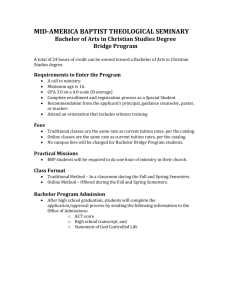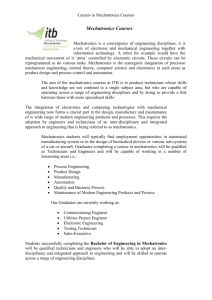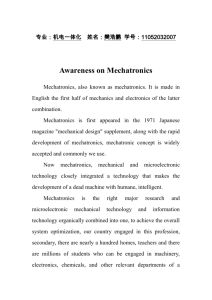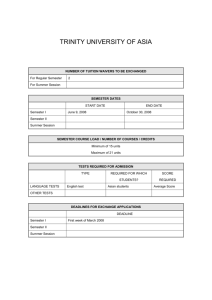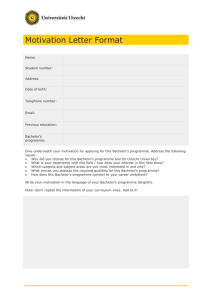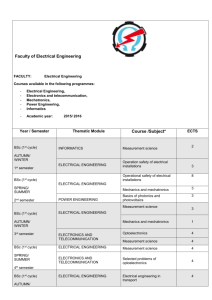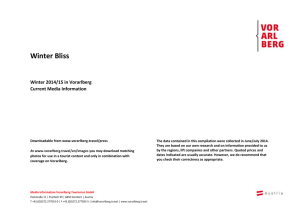A BACHELOR`S PROGRAM AT THE VORARLBERG UNIVERSITY
advertisement
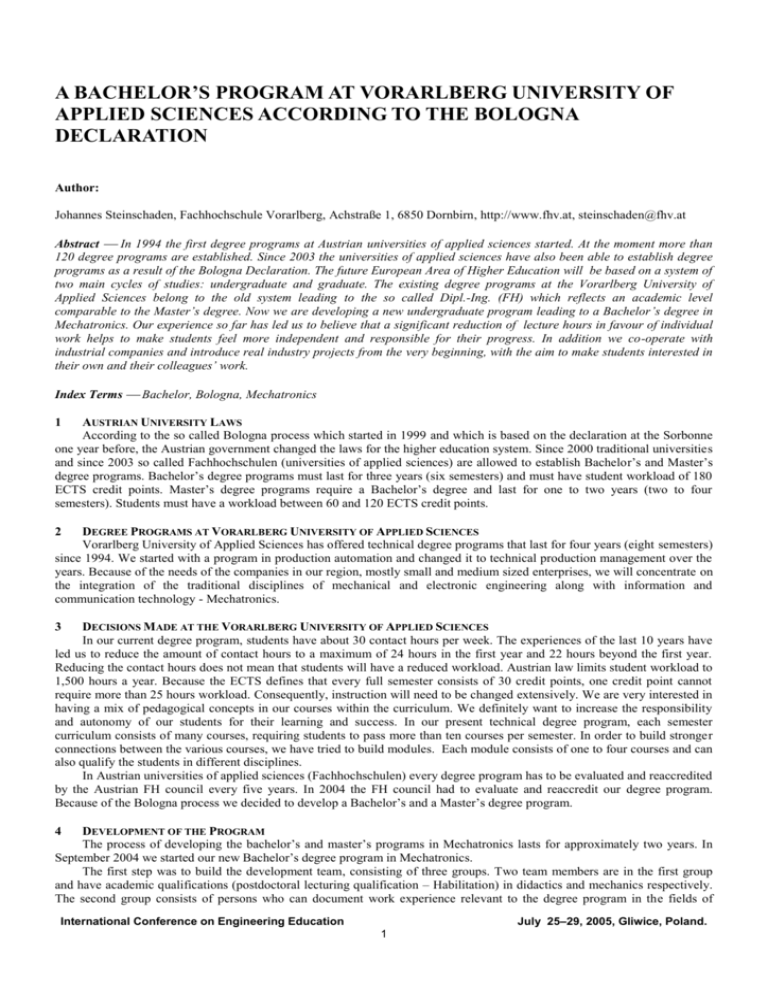
A BACHELOR’S PROGRAM AT VORARLBERG UNIVERSITY OF APPLIED SCIENCES ACCORDING TO THE BOLOGNA DECLARATION Author: Johannes Steinschaden, Fachhochschule Vorarlberg, Achstraße 1, 6850 Dornbirn, http://www.fhv.at, steinschaden@fhv.at Abstract In 1994 the first degree programs at Austrian universities of applied sciences started. At the moment more than 120 degree programs are established. Since 2003 the universities of applied sciences have also been able to establish degree programs as a result of the Bologna Declaration. The future European Area of Higher Education will be based on a system of two main cycles of studies: undergraduate and graduate. The existing degree programs at the Vorarlberg University of Applied Sciences belong to the old system leading to the so called Dipl.-Ing. (FH) which reflects an academic level comparable to the Master’s degree. Now we are developing a new undergraduate program leading to a Bachelor’s degree in Mechatronics. Our experience so far has led us to believe that a significant reduction of lecture hours in favour of individual work helps to make students feel more independent and responsible for their progress. In addition we co-operate with industrial companies and introduce real industry projects from the very beginning, with the aim to make students interested in their own and their colleagues’ work. Index Terms Bachelor, Bologna, Mechatronics 1 AUSTRIAN UNIVERSITY LAWS According to the so called Bologna process which started in 1999 and which is based on the declaration at the Sorbonne one year before, the Austrian government changed the laws for the higher education system. Since 2000 traditional universities and since 2003 so called Fachhochschulen (universities of applied sciences) are allowed to establish Bachelor’s and Master’s degree programs. Bachelor’s degree programs must last for three years (six semesters) and must have student workload of 180 ECTS credit points. Master’s degree programs require a Bachelor’s degree and last for one to two years (two to four semesters). Students must have a workload between 60 and 120 ECTS credit points. 2 DEGREE PROGRAMS AT VORARLBERG UNIVERSITY OF APPLIED SCIENCES Vorarlberg University of Applied Sciences has offered technical degree programs that last for four years (eight semesters) since 1994. We started with a program in production automation and changed it to technical production management over the years. Because of the needs of the companies in our region, mostly small and medium sized enterprises, we will concentrate on the integration of the traditional disciplines of mechanical and electronic engineering along with information and communication technology - Mechatronics. 3 DECISIONS MADE AT THE VORARLBERG UNIVERSITY OF APPLIED SCIENCES In our current degree program, students have about 30 contact hours per week. The experiences of the last 10 years have led us to reduce the amount of contact hours to a maximum of 24 hours in the first year and 22 hours beyond the first year. Reducing the contact hours does not mean that students will have a reduced workload. Austrian law limits student workload to 1,500 hours a year. Because the ECTS defines that every full semester consists of 30 credit points, one credit point cannot require more than 25 hours workload. Consequently, instruction will need to be changed extensively. We are very interested in having a mix of pedagogical concepts in our courses within the curriculum. We definitely want to increase the responsibility and autonomy of our students for their learning and success. In our present technical degree program, each semester curriculum consists of many courses, requiring students to pass more than ten courses per semester. In order to build stronger connections between the various courses, we have tried to build modules. Each module consists of one to four courses and can also qualify the students in different disciplines. In Austrian universities of applied sciences (Fachhochschulen) every degree program has to be evaluated and reaccredited by the Austrian FH council every five years. In 2004 the FH council had to evaluate and reaccredit our degree program. Because of the Bologna process we decided to develop a Bachelor’s and a Master’s degree program. 4 DEVELOPMENT OF THE PROGRAM The process of developing the bachelor’s and master’s programs in Mechatronics lasts for approximately two years. In September 2004 we started our new Bachelor’s degree program in Mechatronics. The first step was to build the development team, consisting of three groups. Two team members are in the first group and have academic qualifications (postdoctoral lecturing qualification – Habilitation) in didactics and mechanics respectively. The second group consists of persons who can document work experience relevant to the degree program in the fields of International Conference on Engineering Education July 25–29, 2005, Gliwice, Poland. 1 Mechanical Engineering, Embedded Systems, Electronics, and Information Technology respectively. The third group consists of primarily internal teaching staff members. To involve our graduates from our former programs was as important to us as the involvement of the relevant companies in the region. An external institution worked out the needs analysis survey based on the companies needs. The alumnae of our former programs were also asked to answer similar questions. We got feedback from more than half of them and had some additional group discussions with alumnae. It was very interesting to get feedback from them because they have both experiences from the degree program as well as from the working environment. One set of questions dealt with the importance of Mechatronics. We tried to assess mechanical engineering, electronic engineering, information technology, and Mechatronics. Another set of questions tried to determine the needs for academic qualifications. In this context we asked for the competences and skills future students should have in order to succeed in industry. We asked how long they should study for these qualifications. Also we asked the companies if they are interested in part time students to promote lifelong learning. Other questions concerned how long these programs should last and what the learning goals should be. Our alumnae answered additional questions about their student life, how much degree program content they could directly apply in their professional work and what content they think could be added to the degree program. We also asked them to tell us which courses we could be phased out. Some questions tried to find out what and how we could enhance the learning outcome. Also we had questions about the organization, the course contents, the workload during the semesters and so on. After making decisions based on the two surveys, we developed the bachelor’s and master’s programs. For every course we defined the learning goals, the necessary work hours for students and small groups, and the amount of time the student needs to complete the course. One of the boundary conditions was the maximum workload per student of 750 hours per semester. We also tried to reduce the contact hours to less than 24 hours a week. To be more flexible with the courses, I decided to define the contact hours per semester for each course and not the contact hours per week. Because of this decision, the courses did not have natural numbers for their hours per week, like one or five hours per week. The Austrian council named two university professors as peers for the review of our proposed programs. They only accepted natural numbers for the course hours per week so we had to change that. Another idea was to integrate different disciplines into modular courses. We thought that we could reduce the contact hours for the students if we connected teachers from different disciplines to one project. The idea was to train students not only on the technical issues in a project but also to gain experience in project work. We also wanted them to reflect on their work. For example, they could design a Mechatronics product, develop a financial plan, reflect on their teamwork, and develop their presentation and documentation skills. The peers did not accept this concept. They argued that we only wanted to lower the quality of the programs and that we wanted to give the students an easy possibility to get a degree. We completely changed the proposals for the degree programs. We found some possibilities to fulfill the wishes of the peers on one hand and to be flexible enough to carry out our own ideas on the other hand. We defined course names with more or less traditional names, but we connected them to the project work during five semesters. Additional coaching hours give us the possibility to realize double teaching. The didactical concept is now based on collaboration of professors from different disciplines. They should develop examples, projects, practical case studies and so on which are connected to their courses. Also the project work theme should be an integrated part of most of the courses during the program. The curriculum of the Mechatronics degree program can be seen in picture 1. 5 PROJECT WORK In the context of real industry-based projects we want to enable different skills. Of course problem solving skills will be the main focus in addition to project management and interpersonal skills within the framework of a technical project. The students will work in teams which will be coached by professors who focus on the technical disciplines as well as by professors who concentrate on project management, team building, conflict management and other interpersonal skills. In these projects, students with different levels of knowledge and experience will have to work together in teams. In each team there will be students from the first, second and third year. Most of the tasks will be at a level that is too advanced for first-year students, requiring the upper level students to take the lead and learn how to manage real project teams. Also we hope that the first-year students will be more interested in future course content in the curriculum because they will see the areas where they lack knowledge. This project enables professors to show the importance of their course contents to the students. Without this type of project, we will have great problems to motivate students to learn and we will need very good arguments for such learning objectives. 6 STUDENT MOBILITY In our present degree program as well as in our future degree program, students can take one semester at another university during their fifth semester. We are very interested that the students get international experience during their studies at the University. For those students who are not able to or are not interested in studying abroad, all courses in the fifth semester will be given in English. So we hope to attract foreign students into our program through student exchanges. 2 International Conference on Engineering Education July 25–29, 2005, Gliwice, Poland. 3 7 TRANSDISCIPLINARY ELECTIVE COURSES Totally new are the so called transdisciplinary elective courses in all programs at Vorarlberg University of Applied Sciences. In these courses students should gain experience outside their discipline. Because we have programs in different disciplines we try to increase the connections between them. At the moment we only offer courses for students of other disciplines, meaning that we offer technical courses for non-engineers and so on. In the future we will offer courses for project work in which students from all programs will collaborate. 8 CONCLUSIONS With the new undergraduate program in Mechatronics we have tried to incorporate some new ideas into the curriculum and hope that more young people will join our technical program at Vorarlberg University of Applied Sciences. International Conference on Engineering Education July 25–29, 2005, Gliwice, Poland. 4
